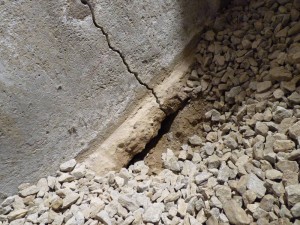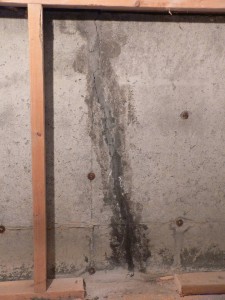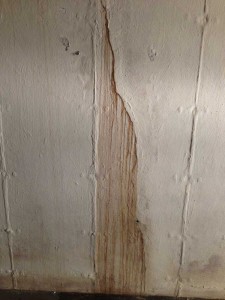Foundation
Crack Repair
Before the mid 1970’s, most residential foundations were built using CMU (Concrete Masonry Unit) block, commonly known as Cinder Block. Since then, solid poured concrete foundations have become the choice for most builders here in New England due to their superior strength, longevity, and cost.
Cracking is the most common form of poured concrete failure, and the repair options can vary depending upon symptoms, intended use, design strength, functionality, and cost.

What Causes Cracks?
Foundation wall cracks occur in New England homes as a result of only a few causes. One is concrete shrinkage. Water is released into the air as concrete goes through the curing (hardening) process. If there is excessive water in the mix or this water is allowed to escape quickly, the concrete may shrink to a level that causes a crack. This is the least significant form of cracking related to a foundation and very common in concrete structures built today. Once the concrete is fully cured and has reached its maximum strength, shrinkage no longer occurs.
The second most common cause for a foundation crack is the excessive force being applied to the concrete. A force is some pressure or loads applied to the concrete which fails a crack. Some common forces large enough to cause this cracking may result from structure settlement, improper site drainage, premature site backfilling, or the use of expansive soils for backfilling. This type of cracking source is important to understand when it comes to choosing a repair method properly. The longevity of your repair depends on it. Other factors such as site/structure design, proper concrete mix design, and final concrete strength can also play into the ultimate cause of a crack but tend to be less likely with today’s building practices.
Did You Know?
Most visible cracks found in residential basement walls extend through the wall. This essentially means that your wall has broken into separate sections and is no longer a monolithic (without joints/seams) structure. This is not the intention of modern-day foundation design and can lead to a higher risk for continual movement problems in your home.
Just because a crack doesn’t leak now doesn’t mean it will never leak. If most cracks go through to the outside, they are all susceptible to water infiltration. The water now has a distinct path from exterior to interior. Not every rainstorm will cause cracks to leak. Some may require specific less common events such as 100- year storms, wind-driven rain, quick snowmelt with the ground still frozen, clogged gutters, or even a leaking or broken irrigation line.

Pressure Injection
Pressure injection is the process of injecting a liquid material into a crack found in a solid poured concrete structure. This process has been a primary method used to repair, restore, and waterproof commercial and industrial structures for over 60 years. It is the preferred method of repair for many Civil/Structural Engineers involved in projects worldwide.
Depending on the type of material used, cracks can be waterproofed or even structurally repaired beyond their design strength, if needed. Since many concrete structures are used in below-grade (underground) applications, repair access can be limited without cost-prohibitive excavation. Similar to residential foundations, this is exactly why pressure injection is an extremely cost-effective method for basement crack repair. Exterior excavation is not needed in residential injection, and interior access is all that is required.

Polyurethane Grout Injection
Polyurethane grout is a chemical liquid used in the waterproofing industry for creating flexible barriers against water penetration, specifically cracks. It is commonly used on below ground infrastructures such as tunnels, dams, mine shafts, and retaining walls. Grout injecting is a versatile method and can be used in many residential sealing applications such as leaking cracks, pipe penetrations tie- rods, joint/seams, and void filling. When injected, urethane grout reacts with water beginning a chemical foaming process creating internal pressures needed to drive the material into small/deep spaces creating a flexible waterproof repair. It is important to understand that Polyurethane offers no structural strengthening properties. It only acts as a gasket and offers no additional strength to the structure or repair area.
Epoxy Injection
Epoxy is an adhesive material used in bonding processes. It’s known for its tenacious ability to join two pieces together, many times, permanently. It’s strength properties are frequently higher than that of the materials being bonded. This is why Epoxies are used in the structural repair of cracked concrete. When the epoxy injection is done properly, it creates a solid monolithic piece of concrete, re-establishing its designed strength. It is a rigid repair meaning it does not allow for additional movement at the repair site. If the crack's cause is still present and determined that structural movement is still possible, the epoxy injection may not be all needed. See Fortress Stabilization
